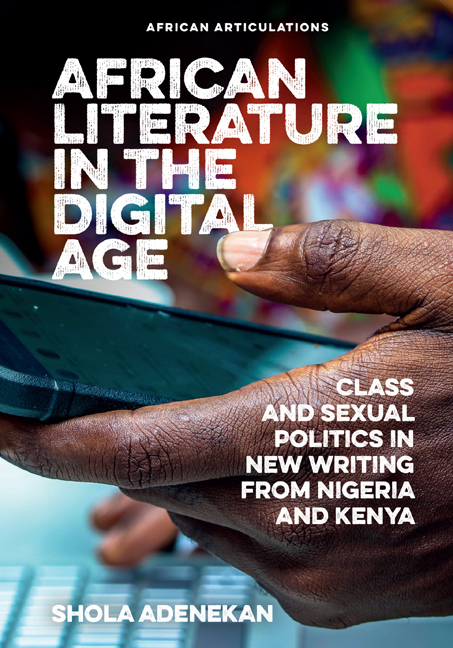 African Literature in the Digital Age
African Literature in the Digital Age Book contents
- Frontmatter
- Dedication
- Contents
- List of Illustrations
- Acknowledgements
- List of Abbreviations
- Introduction: Kenyan and Nigerian Writers in the Digital Age
- 1 Network Thinking: Literary Networks in the Digital Age
- 2 Class and Poetry in the Digital Age
- 3 Class Consciousness in Online Fictions
- 4 Digital Queer: The Queering of African Literature
- 5 Middle-Class, Transnational, Queer, and African
- 6 ‘Ashewo no be job’: The Figure of the Modern Girl in the Digital Age
- 7 The Erotic in New Writing from Nigeria
- 8 Social Media and the Aesthetics of the Quotidian
- Conclusion: Connecting the Dots
- Bibliography
- Index
- Miscellaneous Endmatter
1 - Network Thinking: Literary Networks in the Digital Age
- Frontmatter
- Dedication
- Contents
- List of Illustrations
- Acknowledgements
- List of Abbreviations
- Introduction: Kenyan and Nigerian Writers in the Digital Age
- 1 Network Thinking: Literary Networks in the Digital Age
- 2 Class and Poetry in the Digital Age
- 3 Class Consciousness in Online Fictions
- 4 Digital Queer: The Queering of African Literature
- 5 Middle-Class, Transnational, Queer, and African
- 6 ‘Ashewo no be job’: The Figure of the Modern Girl in the Digital Age
- 7 The Erotic in New Writing from Nigeria
- 8 Social Media and the Aesthetics of the Quotidian
- Conclusion: Connecting the Dots
- Bibliography
- Index
- Miscellaneous Endmatter
Summary
For many Nigerian and Kenyan writers in the new media space, cyberspace sometimes serves as a debut platform for what may later appear in print, but most of these works (sometimes fragmented and, at times, short, intricate pieces) remain within cyberspace. This chapter analyses online writings as reflecting the dynamics of interconnectedness, especially the way in which cultural practices are organised around not just the individual (the author) but also around the collective, in a global network that is the world wide web. This chapter uses the concept of ‘network’ in analysing the many layers of relationship between the analogue terrain of print publication and that of the digital. Having studied computing for my first degree, my understanding of the concept of ‘network’ and its application are both loosely based on networking morphology taught in information technology classes, which relates to the different structures and forms of networks. As a literary theorist, I apply the metaphor of network in unpacking the types of connections to be found within African literatures and within the community of global literatures.
Manuel Castells and Patrick Jagoda provide robust analyses on the concept of the network. Castells sees networks in terms of the global power structure. Networks, he argues, ‘can expand indefinitely, incorporating any new node by simply reconfiguring themselves, on the condition that these new nodes do not represent an obstacle to fulfilling key instructions in their program’ (1996, 695). In The Rise of the Network Society (1996), Castells sees digital networks as disrupting the global order because various digital entities are now able to bypass previously constituted authorities. Building on Castells's theory on the intersection of network and power, Jagoda argues that networks are both cultural and material structures (2016, 2–3). From these two arguments, one can surmise that a network is made up of interconnected entities with shared –and sometimes divergent –interests. In computing, these interests revolve around information and data, and this is the foundation of today's internet and the digital space. On a more rudimentary level, a spiderweb can be conceived as representing the structure of a hub-and-spoke network. The spiderweb as a network has spokes in many different directions that are connected to a central hub, which is the spider itself.
- Type
- Chapter
- Information
- African Literature in the Digital AgeClass and Sexual Politics in New Writing from Nigeria and Kenya, pp. 21 - 46Publisher: Boydell & BrewerPrint publication year: 2021


